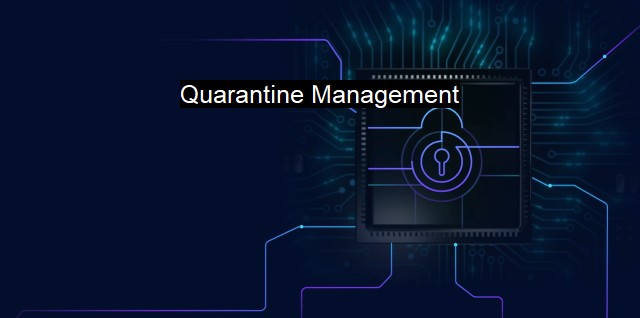What is Quarantine Management?
The Importance of Quarantine Management in Cybersecurity: Keeping Your Systems Secure from Malware and Suspected Threats
Quarantine Management is a common term used in various fields that generally refers to strict isolation to avoid the spread of diseases. with quarantine management takes on a different meaning but somewhat serves the same purpose.Quarantine Management refers to the mechanisms or procedures used to control, mitigate, observe, analyze, and impose decisions on files, emails, websites, or any digital data that are suspected of, or have been confirmed to be harmful. Just as with biological diseases, viruses, worms, malware, spyware, Trojans, and other unwanted cyber threats can spread, multiply, or execute harmful operations within a computer system, network, or even across networks when left unperturbed. Therefore, they need be isolated and managed diligently: that's where Quarantine Management comes into action.
When an antivirus program or any other system protection software app identifies a potentially harmful file, instead of promptly deleting or removing it, the software isolates or "quarantines" the file. This quarantine phase of the file is comparable to putting a possibly sick person in isolation: the file is removed from its natural environment where it has the potential to do more harm and placed in a securely controlled locale where it can be closely observed, researched, and appropriately dealt with.
Most often, the quarantined files are held in stock in a special kind of vault, hidden from influence or access of other system files and operations. Thanks to the cybersecurity Quarantine Management protocols, these files are kept ‘under observation’ in the quarantine vault until they are later ascertained to pose a confirmed threat.
Subsequently, decisive action could be taken, either to absolutely eradicate the file from the storage space in case it is marked down and confirmed as a frightening digital virus or threat. if the antimalware or antivirus solution identifies the file as not perilous after all, the quarantined file could be graciously unchained and restored back to its initial operation or functionality.
The importance and necessity of Quarantine Management within the domain of computer security cannot be overemphasized. Firstly, it saves precious files that might have been wrongfully identified as a threat. Antivirus programs are not 100% efficient in identifying all levels and kinds of threats, leading to instances where they feel a false harmful alarm - commonly referred to as false positive. Instead of having such files deleted once and for all a Quarantine Management procedure that isolates and observes before conclusive action saves these resources.
Secondly, Quarantine Management serves to minimize the spread and damage of proven malware threats within the system space. By immediately isolating the harmful software as soon as it is discovered, The Quarantine Management process considerably restricts the damage that could be caused.
Quarantine Management mirrors the practical aspects in health science but here it deals with the disconnection, and appropriate management of threats in digital forms, aiming to isolate and control possible harm to computer systems. The development and application of efficient Quarantine Management protocols and practices help significantly in shielding systems and networks from a wide range of digital threats. It is a prime pillar in maintaining the health and safety of our cyber environment, a testament to its importance in the digital world.

Quarantine Management FAQs
What is quarantine management in the context of cybersecurity and antivirus?
Quarantine management is a process that involves isolating and containing files or software that are suspected of containing malware or viruses. This is done to prevent the malware from spreading to other parts of the computer system and doing further damage.How does quarantine management help in preventing malware infections?
Quarantine management helps in preventing malware infections by isolating the infected files or software from the rest of the computer system. This prevents the malware from spreading and doing further damage to the system. It also allows antivirus software to scan the infected files or software and either remove the malware or provide a warning to the user.What are the best practices for quarantine management?
The best practices for quarantine management include educating users on how to identify and report suspicious files or software, regularly scanning the computer system for malware, setting up automatic updates for antivirus software, and ensuring that files and software in quarantine are regularly reviewed and either deleted or restored to the system as appropriate.How do I know if a file or software has been quarantined?
If a file or software has been quarantined, it is usually indicated by a message or warning from the antivirus software. This message will usually provide information on the location of the quarantined file or software and what specific malware was detected. Users can also check the quarantine folder of their antivirus software to see which files or software have been quarantined.| | A | | | B | | | C | | | D | | | E | | | F | | | G | | | H | | | I | | | J | | | K | | | L | | | M | |
| | N | | | O | | | P | | | Q | | | R | | | S | | | T | | | U | | | V | | | W | | | X | | | Y | | | Z | |
| | 1 | | | 2 | | | 3 | | | 4 | | | 7 | | | 8 | | |||||||